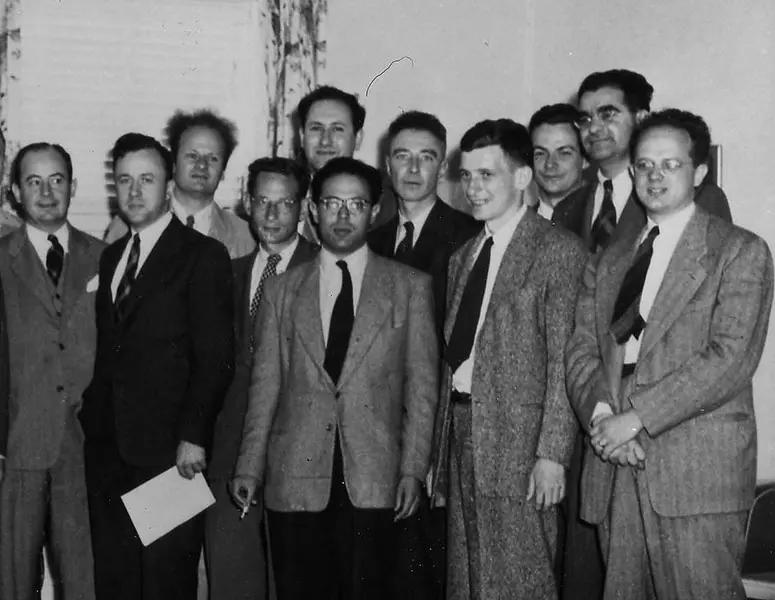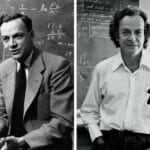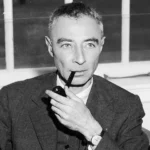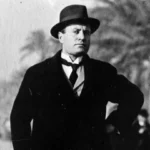Robert Serber, a name often lost in the shadows of more prominent figures, was a physicist whose contributions to science, particularly his role in the Manhattan Project, were nothing short of groundbreaking. Recent research has unearthed fascinating details about his life, shedding light on the enigmatic figure who navigated the complex world of nuclear physics during a time of global turmoil.
Surprising Facts About Robert Serber
You might know about the Manhattan Project, but did you know about Robert Serber, the unsung hero behind the scenes? He wasn’t as publicly known as Oppenheimer, but in the world of physics, Serber was a rockstar—the secret weapon, so to speak.
From Philly to Physics Phenom
Born in Philadelphia in 1909, Serber displayed a natural curiosity for science from a young age. He excelled in academics, earning his bachelor’s degree in chemistry from Haverford College in 1929. His passion for knowledge led him to pursue a doctorate in theoretical physics from the University of Wisconsin-Madison, which he completed in 1934, establishing himself as a rising star in the field.
The Manhattan Project: Where Serber Shined
As World War II erupted, Serber found himself recruited to the most ambitious scientific endeavor in history: the Manhattan Project. Thrust into this clandestine world of high stakes and groundbreaking research, he worked alongside the most brilliant minds of the era to develop the atomic bomb.
Imagine the pressure! The fate of nations rested on the shoulders of these scientists.
Serber’s most notable contribution to the project was his authorship of “The Los Alamos Primer,” a document of paramount importance. It served as a crash course on the atomic bomb for all the scientists involved, becoming an indispensable guide in their quest to unlock the secrets of nuclear fission. Some speculate that the success of the project hinged on the clarity and insights provided in Serber’s primer.
Despite his dedication, the experience of working on such a destructive force deeply affected Serber. In the years that followed, he became increasingly vocal about his concerns regarding the ethical ramifications of nuclear weapons. The profound implications of his work weighed heavily on him, prompting him to advocate for responsible use and control.
Life After the Bomb: Still a Rock Star
After the war, Serber’s scientific journey didn’t end. He continued his research, making significant contributions to high-energy physics and particle scattering. He dedicated years to teaching at UC Berkeley, inspiring a new generation of physicists with his passion for scientific inquiry.
His contributions didn’t go unnoticed. In 1962, Serber received the National Medal of Science, the highest scientific honor bestowed by the United States government, cementing his legacy as a true giant in his field.
Beyond the Lab Coat: The Man of Many Talents
Beyond his scientific achievements, Serber possessed a surprising talent: he was an exceptional pianist. He pursued music lessons throughout his life, finding solace and expression in the world of melodies and harmonies. This artistic side reveals a depth and complexity often unseen in those solely defined by their scientific pursuits.
Passion for Knowledge: A True Teacher
Serber believed that knowledge was meant to be shared and that education held the key to a brighter future. Throughout his career, he mentored numerous students, generously sharing his wisdom and fostering a love for science in those he inspired. He dedicated himself to making complex scientific concepts accessible, believing that everyone should have the opportunity to appreciate the wonders of the natural world.
The Ethical Dilemma: A Change of Heart
Serber’s stance on nuclear weapons underwent a significant transformation. While initially committed to the Manhattan Project’s objectives, his perspective shifted over time. The devastating potential of what they had created haunted him, prompting him to become a staunch advocate for arms control and the prevention of nuclear proliferation.
Robert Serber’s story is a testament to the complexities of a brilliant mind grappling with the profound ethical implications of scientific advancement. He was more than just a brilliant physicist; he was a human being wrestling with the weight of his knowledge and striving to ensure a safer and more peaceful future.
Fun Facts About Robert N. Hall: A Legacy of Innovation
Robert N. Hall, a pioneering engineer and applied physicist, left an indelible mark on the world through his groundbreaking inventions and scientific contributions. Let’s delve into some intriguing trivia about the man behind the science, revealing the person behind the groundbreaking technologies he brought to life.
Did you know that Hall’s work on the “4-level atomic maser” laid the groundwork for one of the most transformative inventions of the 20th century—the laser? That’s right! And his contributions to the world of lasers didn’t stop there. He went on to co-invent the ruby laser, a type of laser that utilizes a special crystal to generate its intense beam. This invention alone revolutionized countless fields, from consumer electronics like CD players to the realm of highly precise laser surgeries.
But wait, there’s more! Remember that indispensable kitchen appliance—the microwave? You can thank Hall for his role in developing the magnetron. Initially used in radar systems during World War II, the magnetron was later adapted for use in microwave ovens, making reheating leftovers a breeze. Talk about a happy accident with a lasting impact!
And it gets even more impressive. Hall was the mastermind behind two crucial methods for manufacturing semiconductor diodes, the tiny electrical components found in virtually every electronic gadget imaginable. Oh, and he also figured out a way to create ultra-pure silicon and germanium, materials that form the backbone of countless electronic devices.
But Hall’s brilliance wasn’t confined to the realms of physics and electronics. He was also an accomplished pianist with a deep appreciation for classical music. This unexpected talent showcases the multifaceted nature of his brilliance, proving that even scientific geniuses have a creative side.
Even today, Hall’s work continues to astound and inspire new generations of scientists and engineers. His legacy as a true visionary whose impact on our lives is undeniable lives on.
Robert Serber’s Pivotal Role in the Manhattan Project
Robert Serber’s contributions to the Manhattan Project extend far beyond his groundbreaking scientific work. Imagine being tasked with explaining the intricate science behind an atomic bomb to a room full of the world’s most brilliant minds. That was Serber’s challenge, and he rose to it brilliantly.
As the project’s designated teacher, he delivered a series of legendary lectures that became affectionately known as “The Los Alamos Primer.” These lectures provided a crash course on the theoretical and practical aspects of nuclear physics, bringing together physicists from diverse backgrounds and ensuring everyone was on the same page. His ability to synthesize complex information and present it in a clear, engaging manner was crucial to the project’s success.
But it wasn’t just about teaching equations—Serber had a knack for making the information stick. How do you make sure no one forgets the names of the bombs they’re building? You give them catchy code names! And guess who came up with “Little Boy,” “Thin Man,” and “Fat Man”? That’s right, it was our man Serber!
His scientific prowess was undeniable, but it was his leadership and communication skills that truly set him apart. He acted as a bridge between different disciplines and personalities, fostering collaboration and ensuring the project stayed on track. In the high-pressure environment of the Manhattan Project, where collaboration was key, Serber’s ability to bring people together was invaluable.
Serber’s profound impact on the Manhattan Project cements his place as a pivotal figure in this pivotal moment in history. His ability to explain, inspire, and lead solidified his legacy as more than just a brilliant physicist but also a key architect in the development of the atomic bomb
The Complex Legacy of the Atomic Bomb: Who Created It?
The creation of the atomic bomb was a monumental undertaking, involving the collective efforts of some of the greatest minds of the 20th century. While J. Robert Oppenheimer, as the scientific director, is often credited as the “father of the atomic bomb,” the reality is far more nuanced. Numerous individuals played critical roles, and it’s important to acknowledge the collective effort that went into this world-altering achievement.
One such figure is, of course, Robert Serber. While Oppenheimer provided the leadership and vision, it was Serber who laid the theoretical groundwork that made the bomb’s creation possible. He was the architect of the scientific framework, educating his colleagues on the complexities of nuclear fission and its weaponization. To put it another way, if Oppenheimer was the conductor of this grand, albeit terrifying, orchestra, then Serber was the composer who wrote the score.
But Serber’s contribution goes beyond just laying the groundwork. He was deeply involved in the intricate details of the project, figuring out the complex physics behind the bomb’s assembly, a process known as bomb assembly hydrodynamics. He even acted as an advisor to the US military, bridging the gap between scientific breakthroughs and their real-world applications.
What’s particularly striking about Serber’s story is his transformation in the aftermath of the war. Haunted by the destructive potential of what he had helped create, he became a vocal advocate for nuclear arms control. This internal struggle highlights the moral dilemmas faced by the scientists who participated in the project, many of whom grappled with the weight of their creations.
While the Manhattan Project was undoubtedly a collaborative effort involving countless individuals, certain figures stand out. Let’s summarize their roles:
| Figure | Role | Significance |
|---|---|---|
| J. Robert Oppenheimer | Scientific Director, Manhattan Project | Led the project, often called the “father of the atomic bomb” |
| Robert Serber | Theoretical Physicist | Developed the theoretical framework for the bomb; grappled with the moral implications |
Clarifying “The Server” in the World of Oppenheimer: A Case of Mistaken Identity
The world of “Oppenheimer” and the Manhattan Project is filled with fascinating figures, but the term “server” might be a bit misleading. In today’s world, we think of servers as powerful computers, but in the context of the Manhattan Project, it doesn’t quite fit.
It seems the question might be seeking information about a specific individual involved in the project, and while the movie “Oppenheimer” focuses on specific characters, it doesn’t encompass every key player. One such figure, whose role was critical but often overlooked, is physicist Robert Serber.
Serber’s absence from the film doesn’t diminish his impact. He was the intellectual bridge that brought the Manhattan Project together. Imagine a room filled with the most brilliant minds, all working on a project of unprecedented scale and complexity. It would be overwhelming, wouldn’t it? Serber provided the roadmap—his series of lectures, “The Los Alamos Primer,” became legendary, laying out the scientific foundation and unifying the project’s diverse team.
But Serber’s influence went far beyond setting the stage. He was deeply involved in the project’s intricate details. He played a key role in unraveling the complex physics behind how the bomb would be assembled—a process known as bomb assembly hydrodynamics. He also served as a vital advisor to the US military, translating scientific advancements into real-world strategic implications.
And here’s a fascinating tidbit: it was Serber who coined the now-iconic code names for the atomic bombs: “Little Boy” and “Fat Man.” These names, etched in history, highlight his lasting influence on how we remember and understand the Manhattan Project.
Perhaps the most compelling aspect of Serber’s story is his transformation after the war. Witnessing the devastation wrought by the atomic bombs, he became a staunch advocate for nuclear arms control. His journey reflects the profound moral dilemmas faced by many involved in the Manhattan Project, forcing them to confront the devastating consequences of their creations.
So, while Robert Serber might not be a household name, his contributions were instrumental to the Manhattan Project’s success. Understanding his role provides a richer, more nuanced understanding of the project’s complexities and the human stories behind this pivotal moment in history.
Unveiling Robert Plot: The Original “Fossil Hunter”
Robert Plot, a 17th-century English naturalist and antiquarian, might not be as well-known as some of his contemporaries, but his contributions to the world of science are significant. Let’s uncover some intriguing facts about this fascinating figure who bridged the gap between natural history and the nascent field of paleontology.
Imagine stumbling upon the very first dinosaur bone ever documented! That’s exactly what Robert Plot did. Of course, back then, the concept of dinosaurs as we understand them didn’t exist. Plot, like many at the time, theorized that the massive bone belonged to a giant human or perhaps a mythical creature. It’s a fascinating example of how scientific understanding evolves over time, with each new discovery reshaping our knowledge of the natural world.
Plot’s insatiable curiosity led him to travel extensively throughout England, meticulously documenting his findings in his book, “The Natural History of Oxfordshire.” This groundbreaking work, filled with detailed descriptions and illustrations of plants, animals, fossils, and minerals, offered a fascinating glimpse into the natural world of 17th-century England. He was like a proto-blogger, sharing his passion for nature with the world!
In addition to his field research, Plot held the esteemed position of the first chemistry professor at Oxford University. As if that wasn’t enough, he also founded the Ashmolean Museum, which continues to inspire and educate visitors with its vast collection of art and antiquities. Talk about leaving a lasting legacy!
It’s important to acknowledge that while Plot was a brilliant mind, some of his ideas might seem a bit unorthodox today. For example, attributing the giant bone he discovered to a giant, while understandable given the limited knowledge of the time, underscores the evolving nature of scientific understanding. Science, after all, is a journey of discovery, and even the most brilliant minds are constantly refining their understanding based on new evidence.
Robert Bunsen: Beyond the Burner
Robert Bunsen, the celebrated German chemist, is often associated with his namesake invention—the Bunsen burner. However, this ingenious tool is only a small part of his remarkable legacy. Prepare to be amazed by some fun facts about the man behind the burner!
Light and Its Secrets:
Bunsen held an unwavering fascination with light and its interactions with matter. This fascination led him to pioneering work in the field of spectroscopy—the study of the interaction of electromagnetic radiation with matter. He discovered that by analyzing the unique light patterns emitted by different substances, one could identify their chemical composition. This groundbreaking discovery, known as spectroscopy, revolutionized not just chemistry but also astronomy and physics, giving scientists a powerful new tool to decode the universe’s secrets.
The Iconic Bunsen Burner:
While Bunsen is often credited with inventing the Bunsen burner, it was actually a collaborative effort with his lab assistant, Peter Desaga. However, the design we recognize today—a device that provides a clean, adjustable flame—is largely attributed to Bunsen’s meticulous refinements. The Bunsen burner remains a staple in laboratories worldwide, from high school classrooms to cutting-edge research facilities, a testament to its enduring utility and the ingenuity of its namesake.
Real-Life Superhero:
Bunsen’s scientific prowess wasn’t confined to theoretical pursuits. He was also deeply invested in using his knowledge for the betterment of humanity. In the 19th century, arsenic poisoning was a serious public health concern. Bunsen, recognizing the urgent need for an effective treatment, stepped up and developed an antidote. His discovery of ferric hydroxide, a compound that could neutralize arsenic’s toxic effects, undoubtedly saved countless lives, solidifying his legacy as both a scientific pioneer and a humanitarian.
The Musical Chemist:
Beyond his scientific brilliance, Bunsen was also a gifted musician. He was proficient in playing several musical instruments, seeking solace and inspiration in the harmonies and melodies of the musical world. This lesser-known aspect of his life reveals a well-rounded individual with a passion for both the arts and sciences—a true Renaissance man!
A Legacy of Discovery:
It’s important to remember that our understanding of historical figures like Robert Bunsen continues to evolve as new information emerges. Nonetheless, his contributions to chemistry and beyond remain undeniable. His relentless pursuit of knowledge, coupled with his desire to use science to improve the human condition, continues to inspire generations of scientists worldwide.
Stanley Hall: A Pioneer of American Psychology
Stanley Hall, often hailed as the “father of American psychology,” was a towering figure in the field, leaving behind a legacy that shaped the discipline for generations. But beyond his groundbreaking accomplishments, there are fascinating aspects of his life and beliefs that offer a glimpse into the complexities of this influential figure.
The “Perfect Head”:
Can you imagine a time when the shape of your head was considered a window into your personality? Welcome to the world of 19th-century phrenology, a pseudoscience that fascinated many, including, to some extent, Stanley Hall. He had what was considered a “perfect head” due to its symmetry, which, according to phrenologists, was a testament to his intellectual capabilities. It’s a humorous reminder of how scientific thought evolves and how even brilliant minds can be influenced by the prevailing beliefs of their time.
A Thirst for Knowledge:
Stanley Hall’s dedication to knowledge was nothing short of extraordinary. He amassed an impressive eight degrees throughout his life, showcasing his diverse interests and thirst for learning. Holding doctorates from both Harvard and the University of Leipzig, he immersed himself in various disciplines, constantly seeking new challenges and expanding his understanding of the world.
Champion of Child Development:
One of Hall’s most enduring legacies is his pioneering work in the field of child development. He established the first laboratory in the United States explicitly designed to study children, believing that a scientific approach was essential to understanding their development. His research laid the foundation for the field of developmental psychology, emphasizing the importance of understanding the unique needs and challenges of children.
Nature Enthusiast and Conservationist:
Beyond the halls of academia, Hall was an avid outdoorsman and a dedicated member of the Sierra Club, a renowned environmental organization. His love for nature extended beyond intellectual curiosity, reflecting a deep respect for the natural world and its preservation.
A Prolific Writer:
Throughout his career, Hall authored over 1,000 articles and books, cementing his status as one of the most prolific writers in the history of psychology. His vast body of work addressed a wide range of topics, from education and adolescence to the psychology of religion, influencing generations of scholars.
Eugenics and a Complicated Legacy:
While Hall made significant contributions to psychology, it’s essential to acknowledge the darker aspects of his beliefs. He was a proponent of eugenics, a now-discredited movement that advocated for selective breeding to improve the human race. This aspect of his legacy is a stark reminder that even brilliant minds can hold harmful and discriminatory beliefs.
Stanley Hall’s life is a study in contrasts—a brilliant mind who helped shape the field of psychology while simultaneously holding beliefs that are now considered reprehensible. His story reminds us that scientific progress is not linear, and even the most influential figures can be flawed. By understanding his achievements and his failings, we gain a more nuanced view of the evolution of psychology and the importance of critical thinking in scientific inquiry.
Independence Hall: More Than Just a Signature Location
Independence Hall, a UNESCO World Heritage Site, is more than just a beautiful building with a famous name. It’s a treasure chest of American history, filled with fascinating stories and hidden secrets that reveal the spirit of a nation in its infancy.
The Liberty Bell’s Journey:
The Liberty Bell, with its iconic crack, is synonymous with American freedom. But did you know it started its life at Independence Hall? From 1753 to 1852, the bell resided in the Hall’s steeple, its resonant peals marking significant events. While the exact cause of its famous crack is debated, some historians believe it first appeared while the bell was ringing to announce the reading of the Declaration of Independence. Talk about making a grand entrance!
Secrets in the Vaults:
Beneath Independence Hall lie secret underground vaults—think National Treasure, but real! During the Revolutionary War, these vaults safeguarded the Declaration of Independence, the Constitution, and other crucial documents from the prying eyes of the British. Can you imagine the tension and the whispered conversations that took place in those dimly lit spaces?
From Courthouse to Cradle of a Nation:
Believe it or not, Independence Hall wasn’t always about politics and revolution. Its elegant Georgian architecture with its intricate carvings and majestic clock tower originally housed a courthouse! It wasn’t until after Pennsylvania declared its independence from British rule that the building assumed its pivotal role as the statehouse.
A Building of Many Hats:
Over the years, Independence Hall took on several surprising roles. In the 1800s, it housed a dog pound, and in the 1900s, it served as a natural history museum! It seems this iconic building, witness to the birth of a nation, also provided a temporary haven for lost pups and a showcase for the wonders of the natural world.
Replicas and Recognition:
The Liberty Bell on display at Independence Hall is the real deal, but you can find replicas scattered throughout the United States, each one a testament to its enduring symbolism. There’s even a replica at Disneyland!
In 1956, Independence Hall was declared a National Historic Landmark, rightfully earning its place as a symbol of American ideals and a reminder of the nation’s journey toward freedom.
George Cleveland Hall: A Champion for Health, Education, and Equality
Dr. George Cleveland Hall was more than just a doctor; he was a tireless advocate for the African American community in Chicago, dedicating his life to improving their health, education, and social standing. Let’s uncover some fun facts about this remarkable man who left behind a legacy of compassion and achievement.
Chicago’s Beloved Physician:
Dr. Hall was a medical icon in Chicago’s Black community, serving as their trusted physician for over three decades. His reputation as a skilled and compassionate doctor earned him the respect and admiration of countless individuals. He was also a surgeon at Provident Hospital, a landmark institution established in 1891 as the nation’s first Black-owned and operated hospital.
A Catalyst for Black History Month:
While not the sole creator of Black History Month, Dr. Hall played a pivotal role in its inception. He was one of the founders of the Association for the Study of African American Life and History (ASALH) in 1915. This organization recognized the importance of preserving and celebrating Black history and spearheaded the movement to dedicate a time to recognize the achievements and contributions of African Americans.
Breaking Barriers at the Library:
Dr. Hall’s commitment to education extended beyond the walls of his medical practice. He was appointed to the board of directors for the Chicago Public Library, becoming the first Black Chicagoan to hold this esteemed position. He tirelessly advocated for equal access to education for all children, regardless of race, believing that education was the key to social and economic advancement.
Honored and Remembered:
Dr. Hall’s contributions to Chicago didn’t go unnoticed. He received two honorary degrees, a testament to his impact on the city and its residents. In 1932, the George Cleveland Hall branch of the Chicago Public Library was dedicated in his honor, ensuring that his legacy of learning and community service would live on.
Inspiring Future Generations:
Dr. Hall’s life is a testament to the power of perseverance, compassion, and unwavering dedication to social justice. He never wavered in his fight for equality and access, inspiring generations to come with his unwavering spirit and belief in the power of education to uplift communities.
If you’re eager to learn more about this extraordinary individual, check out “George Cleveland Hall” on The HistoryMakers website: www.thehistorymakers.org/biography/george-cleveland-hall-41.
Hall & Oates: Unveiling the Secrets of an Iconic Duo
Hall & Oates, the pop-rock duo whose catchy melodies and soulful vocals defined a generation, have a few surprises up their sleeves. Let’s dig into some eyebrow-raising anecdotes and unexpected tidbits that reveal the men behind the music.
The Mailbox Myth:
The story goes that the duo named themselves after a random mailbox they spotted outside their apartment. While it makes for a charming tale, some music historians suggest that the mailbox origin story might be more legend than reality. Bands often embellish their early days, adding a dash of mystique to their image. Truth or myth, the name “Hall & Oates” has a ring to it, capturing their partnership perfectly.
Chart Domination and Beyond:
Six Billboard Hot 100 number-one hits—that’s impressive by any standard! They outsold legendary duos like Simon & Garfunkel in terms of certified units. Their impact goes far beyond the numbers. Songs like “Maneater,” “Rich Girl,” and “Kiss on My List” transcended mere hits, becoming the soundtrack of the late 70s and 80s, forever entwined with memories of weddings, proms, and late-night radio dedications.
Musical Chameleons:
While often labeled as blue-eyed soul, Hall & Oates defied categorization. Their sound—a rich tapestry woven from rock, pop, and even new wave influences—showcased their musical versatility. Their willingness to experiment and evolve while staying true to their core sound explains their enduring appeal.
A Partnership Built on Chemistry:
Daryl Hall’s classical training brought a sophisticated edge, while John Oates’s love for rhythm and blues provided the groove. But what truly set them apart was their musical synergy—an almost telepathic understanding of each other’s strengths. Their voices blended seamlessly, their songwriting complemented each other’s styles, and their onstage presence was electric.
A Legacy Still Resonating:
Hall & Oates’s influence can be heard in the music of countless artists, from Bruno Mars to The Killers. Their music continues to find new audiences, proving that their catchy melodies and soulful sound transcend generations. They’re not just a nostalgic throwback; they’re a vital part of the musical landscape, reminding us that great music never goes out of style.
This is just a peek into the fascinating world of Hall & Oates. There are countless stories and trivia tidbits out there, waiting to be discovered. So, put on your favorite Hall & Oates record, and let their timeless music take you back to a time when blue-eyed soul ruled the airwaves.
Want to explore more fascinating figures? Dive into our intriguing facts about Sam Morelos or discover the remarkable career of Doug Williams in our compilation of facts about Doug Williams.
- Discover the Borough of Frenchtown, NJ: A Delaware River Town Blending History, Art & Nature - November 22, 2024
- Discover Clarks Grove, MN: A Small Town with a Big Heart - November 22, 2024
- Califon Borough, NJ: A Small Town with a Big Heart (and Rich History) - November 22, 2024













